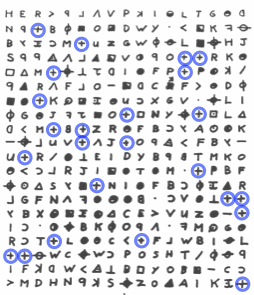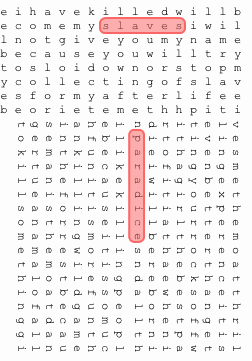One of the strange characteristics of the z340 is the frequency of the "+" symbol compared to all the others. It appears 24 times in the cipher, which is twice as much as the second most frequent symbol. By itself, it represents 7% of the cipher’s size. This is peculiar because in a homophonic substitution cipher, the most frequent plaintext letters will be represented by multiple symbols in order to flatten the frequency distribution and "hide" the more frequent letters. This is the case for the z408, where each symbol appears on average 7.6 times and the distribution is quite flat. If it weren’t for the "+" symbols, this would actually be even more the case for the z340 where each symbol appears on average only 5.4 times (5.1 if you exclude the "+" symbol); the author of the z340 deliberately chose to leave a disproportionate amount of "+" symbols while flattening the distribution of all the other symbols.
I am attempting in this post an explanation to the high frequency of the "+" symbol by presenting a theory on the nature of the z340.
In this theory, the z340 is not a cipher and does not intrinsically contain a message. The "+" symbols are the only significant elements of the z340. Together, they act as a stencil to be applied on a grille cipher (here is a description of what a grille cipher is: http://en.wikipedia.org/wiki/Grille_(cryptography) ). In other words, the z340 must be superimposed on a specific piece of text in such a way that each "+" will be applied on a letter of that text. Reading all 24 of these letters will reveal the hidden message.
Supposing this theory is correct, the rest of the z340 could actually still contain a message or it could be insignificant filler.
In the diagram below, I circle in blue all the "+" symbols in the z340. This set of circles will become my stencil.
When testing this idea out, in order to determine if a series of 24 letters is possibly meaningful, my quality criteria are:
– Use all the letters.
– Form complete and proper words with little to no errors.
– Form a proper sentence.
– Read the letters in a systematic or organized way, i.e. reading the letters should be done in a flow and not at random. In other words, 2-D anagramming is not acceptable.
To test this theory, the first piece of text that came to mind that is easily useable is the z408 solution. I tried to apply the z340 "+" stencil in all possible positions and orientations on the z408 solution but only obtained gibberish.
I then tried to split the z408 solution in the original 3 pieces of size 17×8 letters. While testing out possibilities with these 3 pieces, I had a flash about the Halloween card. Since one piece contains the word "paradice" and another contains the word "slaves", I placed the "paradice" piece perpendicularly to the "slaves" piece and aligned them at the "A" letter of "slaves". I placed the 3rd piece in order to complete the rectangle. Here is what this new z408 solution looks like:
With this disposition, the number of ways to place the full stencil is very limited. By rotating the stencil by 180 degrees and placing it at the top, I immediately saw the word "eyes" pop-out in the top-left corner. I then started to collect all the 24 letters pointed to by the stencil in that position. After a few minutes of playing with these letters, I could make out an intelligible sentence. The diagram below shows how to read the letters. Here are some notes regarding the diagram:
– All 24 letters are encased in the stencil’s blue circles.
– The order in which letters should be read in a word is indicated by blue arrows.
– All words are boxed in red rectangles.
– The order in which words should be read in the sentence is indicated by red arrows.
– The sentence starts with the word "I".
With some punctuation added, here is the sentence:
"I let my eyes forget her sin", RH
The last 2 letters, that I interpret as initials, could be "HR" or "RH".
A few things I find interesting about this sentence:
– It meets all the criteria I stated above.
– It starts with "I", which I find very fitting for a zodiac correspondence.
– It ends with the letters RH, the same initials as the desktop poem. The initials are composed of 2 contiguous letters in the plaintext and not 2 loose letters that didn’t fit anywhere else.
– It mentions "eyes", a topic strongly tied to the Halloween card.
– I find it has a poetic and ominous tone which, again, I find very fitting for a zodiac correspondence.
Of all the ways to apply the z340 stencil to the z408, this is by far the best result I got. There might be other non-zodiac bodies of text this template could be applied to but then the possibilities become endless, unless a hint can point us to the right text. But, to be frank, I kind of like this solution. ![]()
_pi
Hi _pi,
Wow! Brilliant work!
Interestingly, it looks like it also makes use of one of the junk letters at the end of the 408.
Regards,
G
My head is spinning trying to understand the math here ![]() I certainly am interested in the RH aspect
I certainly am interested in the RH aspect
There is more than one way to lose your life to a killer
http://www.zodiackillersite.com/
http://zodiackillersite.blogspot.com/
https://twitter.com/Morf13ZKS
That’s a very creative approach, pi. Interesting work!
I’m curious about the "constrained anagramming" aspect of this approach. Unconstrained anagramming would permit an astronomical number of possible rearrangements of the 24 symbols. But you have enforced some constraints on the selection of a route through the symbols, limiting the number of rearrangements (but not eliminating them entirely). My questions would be:
1) How many different valid ways are there to select the red boxes?
2) For each box, how many different ways are there to read the symbols along a path that does not intersect itself?
3) How many different ways are there to "connect" the boxes using a path that does not intersect itself? (disallowing cases where the path does not interrupt the flow of the paths within each box)
4) How many different ways are there to place the grille on a permitted transposition of pieces of the 408’s plaintext?
I suspect that the number of permutations of the above four quantities is still high enough to produce more than one interesting solution. It’d be a fun challenge to try to find them!
I suspect that the number of permutations of the above four quantities is still high enough to produce more than one interesting solution. It’d be a fun challenge to try to find them!
I did quite a bit of manual verifications without success other than the sentence above but I will take on the challenge and programmatically try to extract other sentences by implementing an algorithm that essentially searches for solutions respecting all the criteria I specified in my post.
Good luck! It sounds like a difficult programming job, since you have to test for valid words, AND they have form a somewhat grammatically correct sentence. The former is easy to check for; the latter might take some extra work!



